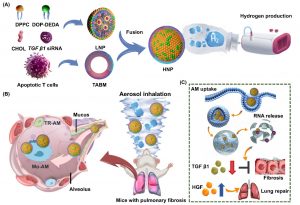A research team led by Zheng Ying, professor in the Institute of Chinese Medical Sciences (ICMS) and Liu Tzu-Ming, associate professor in the Faculty of Health Sciences at the University of Macau (UM), has developed a highly efficient aerosol inhalation system. The system can promote lung tissue repair and effectively block fibrogenic signalling pathways, providing an innovative strategy for the clinical treatment of pulmonary fibrosis. The research has been published in the prestigious interdisciplinary journal Science Advances.
Pulmonary fibrosis (PF) is a chronic, progressive, and fatal interstitial lung disease with limited therapeutic options. Recent advancements in pulmonary gene therapy have shown the potential to halt or even reverse PF, particularly by focusing on correcting gene mutations in alveolar epithelial cells. Although gene therapies targeting alveolar epithelial cells have shown potential, their clinical application remains limited by technical bottlenecks in pulmonary delivery systems. To overcome these barriers, the research team developed an aerosol inhalation system that integrates three components: (1) a vibrating mesh nebuliser to aerosolise lipid nanoparticles (LNPs); (2) a hydrogen supplement system that exploits the low viscosity and anti-inflammatory properties of hydrogen to enhance mucus penetration; (3) a controlled dosing chamber to enable precise therapeutic delivery. The study hypothesised that hydrogen’s unique physicochemical properties (such as lower Reynolds numbers) could improve alveolar deposition and alleviate oxidative stress.
Rather than targeting epithelial cells, this strategy focused on profibrotic alveolar macrophages (AMs), which drive PF progression via TGFβ1 secretion. The team developed a hybrid lipid nanoparticle (HNP) by combining T cell apoptotic body membranes with pH-responsive DOP-DEDA lipids, allowing macrophage-specific targeting and enhanced endosomal escape. These HNPs delivered TGFβ1 siRNA to macrophages, suppressing fibrotic signalling while stimulating hepatocyte growth factor (HGF) production to promote lung tissue repair. The hydrogen-nebulised HNPs demonstrated stability during nebulisation and effectively penetrated the mucus barrier through laminar flow-assisted positive pressure. This approach not only blocks fibrotic pathways but also reprogrammes macrophage phenotypes, modulating the lung microenvironment to achieve sustained therapeutic effects. By integrating hydrogen gas with hybrid LNPs, the study presents a dual-action therapy that addresses both the delivery challenges and disease mechanisms of PF, offering a promising avenue for long-term treatment.
The corresponding author of the study is Prof Zheng Ying, with Prof Liu Tzu-Ming as co-corresponding author. The first author is Liu Chang, a PhD graduate in ICMS. The research was supported by the Science and Technology Development Fund of the Macao SAR (File No: 005/2023/SKL, 0086/2021/A2, 0003/2023/RIC, 0013/2023/RIC), UM (File No: MYRG-GRG2023-00159-ICMS-UMDF, MYRG-CRG2022-00009-FHS), NMPA Key Laboratory for Quality Control and Evaluation of Pharmaceutical Excipients and Guangdong Institute for Drug Control (File No: KF2022015). The full text of the study is available at: https://www.science.org/doi/10.1126/sciadv.adt2752.
| Source: Institute of Chinese Medical Sciences | |
| Media Contact Information: | |
| Communications Office, University of Macau | |
| Albee Lei | Tel: (853) 8822 8004 |
| Bell Leong | Tel: (853) 8822 8009 |
| Email: | prs.media@um.edu.mo |

